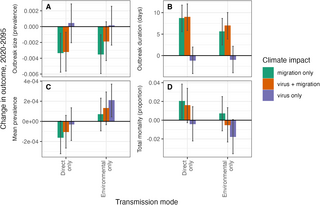Emerging infectious diseases are increasingly threatening wildlife populations, as evidenced by recent outbreaks of avian influenza viruses among wild birds. Climate change complicates these infection dynamics by altering factors such as pathogen decay rates and host migration patterns. In a recent study, researchers adapted a mechanistic model that integrates migration and infection to examine how specific traits of highly pathogenic avian influenza (HPAI) viruses affect their influence on migratory waterfowl populations. The researchers also used the model to predict how climate change may further alter HPAI dynamics.
The findings revealed a broad spectrum of impacts on host populations, ranging from no effect to complete mortality (up to 100% mortality), contingent on the viral traits involved. Specifically, traits associated with the virus’s transmission capabilities—such as contact and shedding rates—were found to be more significant in determining HPAI outcomes than other traits, including environmental temperature sensitivity and cross-protective immunity.
To assess the potential impacts of climate change, the researchers simulated various scenarios under altered temperature conditions. A notable finding was that an advance of nine days in spring migration increased the duration of HPAI outbreaks, resulting in higher mortality rates and lower infection prevalence due to the increased time spent by birds at breeding grounds. Conversely, elevated decay rates of the virus in warmer years led to less severe impacts. The effects of climate change on HPAI dynamics depended greatly on the primary mode of transmission, whether direct or environmental, and the virus’s sensitivity to temperature shifts.
Overall, the results indicate a likelihood of heightened HPAI impacts on waterfowl populations due to climate warming, particularly if the viruses rely heavily on direct transmission methods and if migratory patterns continue to advance in spring.
Author Summary
Infectious diseases, particularly avian influenza viruses, present significant challenges for wildlife, leading to increased mortality rates in certain bird populations. The study emphasizes that the severity of avian influenza impacts on wild birds may rise due to both viral changes and shifting environmental conditions caused by climate change. Through a series of simulations, the research demonstrates that more severe impacts on bird populations are correlated with higher transmission rates, longer infection durations, and lower immunity from prior infections. Future climate scenarios may shift how avian influenza affects these populations, with the directional outcome—whether protective or harmful—largely determined by viral characteristics and the adaptive responses of wild birds.
Introduction
The emergence of new infectious diseases has escalated dramatically over the last century, creating urgent threats to wildlife and human health. Key factors contributing to this trend include climate change, which affects disease transmission directly and alters species distributions. In wildlife, the impact of highly pathogenic avian influenza (HPAI) has become increasingly pronounced over the decades.
Since its emergence in Eurasia in 2020 and subsequently in the Americas, the HPAI H5 clade 2.3.4.4b highlights the significant mortality rates experienced by various bird populations, including those previously unaffected, such as some waterfowl and colonially nesting seabirds. The shifting dynamics of HPAI may mirror evolving viral traits, including increased virulence and slower decay rates in the environment, prompting broader epidemics.
Modeling HPAI Dynamics
In the study, a mechanistic model simulates the interaction of HPAI traits and climate conditions affecting a population of migratory Pacific greater white-fronted geese. This species plays a critical role in HPAI ecology, as they can both disperse and succumb to HPAI outbreaks. The model analysis assesses both short-term metrics, such as the probability of viral invasion, infection prevalence, and mortality, as well as longer-term outcomes like persistence and mean infection rates.
The researchers utilized detailed environmental data and parameters relevant to HPAI transmission modes, creating simulations to explore the impacts of climate change on infection dynamics. They determined that HPAI could successfully invade and persist within the goose population under various viral trait conditions, with significant interactions between different transmission modes.
Results
Following extensive simulations, they concluded that HPAI strains with distinct traits exhibited varying impacts on infection outcomes under different climate scenarios. Notably, direct transmission was found to be the most significant predictor of HPAI invasion success. Additionally, several variables influencing persistence probability, infection prevalence, and mortality rates were closely linked to viral-induced mortality and recovery rates, both critical in shaping the ecological and epidemiological landscape for migratory birds.
Climate Change Considerations
As climate models forecast substantial increases in temperatures, the research indicates these changes will likely vary across different migratory sites. Projections suggest that temperatures could rise by 6.52°C by 2095. The study’s simulations revealed complex relationships between climate impacts and HPAI dynamics, with differing effects underscoring the importance of viral traits in determining overall outcomes.
Conclusion
The research underscores the multifaceted impact of climate change on avian influenza dynamics and the complexities of predicting future trends. Understanding the interaction between viral traits and changing environmental factors remains crucial for forecasting the implications for wildlife and informing conservation efforts. Integrating results from mechanistic models with observational studies could enhance predictive capabilities concerning the future dynamics of avian influenza in wild bird populations amid climate change.






